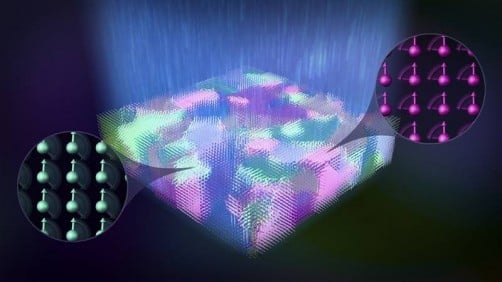Summary: Researchers have demonstrated that light can modify the electrical properties of special materials called relaxor ferroelectrics in just trillionths of a second, opening new possibilities for ultra-fast electronic devices and energy storage systems.
Estimated reading time: 6 minutes
Scientists have achieved a breakthrough in controlling the behavior of advanced materials at unprecedented speeds. Using ultra-fast laser pulses and electron beams, researchers have shown how light can manipulate the electrical properties of relaxor ferroelectrics – specialized materials with applications ranging from sensors to energy storage – in mere picoseconds.
Understanding Relaxor Ferroelectrics
These unique materials possess distinct electrical properties due to their microscopic domain structure – tiny regions where electrical polarization aligns in specific directions. What makes them special is their enhanced electrical and mechanical properties compared to regular ferroelectric materials. Think of them as microscopic compass needles that can be reoriented, but instead of pointing north, they point in directions that create useful electrical properties.
Speed and Control
The research focused on a specific relaxor called PMN-0.32PT, using the Ultrafast Electron Diffraction (UED) Facility at the Linac Coherent Light Source. The team employed:
- A femtosecond laser operating at 266 nanometers
- High-energy electron beams lasting 100 femtoseconds
- Advanced phase-field simulations to understand the results
The scientists discovered they could modulate both the magnitude and direction of polarization in these materials using light pulses. This level of control at such extreme speeds opens new possibilities for advanced electronics and energy storage technologies.
Knowledge Check
- Q: How fast can light modify the properties of relaxor ferroelectrics? A: In a few trillionths of a second (picoseconds)
- Q: What facility was used for the ultrafast electron diffraction measurements? A: The Linac Coherent Light Source (LCLS)
- Q: What properties can be modified in the relaxor domains? A: The magnitude and direction of polarization
Glossary of Terms
- Ferroelectric Materials: Materials with electrically positive and negative sides that can be switched
- Relaxor Ferroelectrics: Special ferroelectric materials with enhanced electrical and mechanical properties
- Domain Structure: Microscopic areas where electrical polarization aligns in specific directions
- Femtosecond: One quadrillionth of a second
- Picosecond: One trillionth of a second
- Phase-field Simulation: Computer modeling technique to understand material behavior
Enjoy this story? Get our newsletter! https://scienceblog.substack.com/


